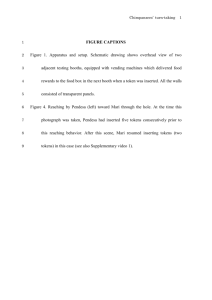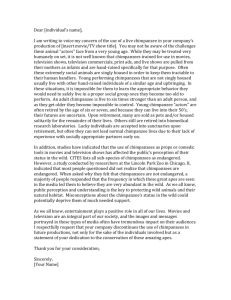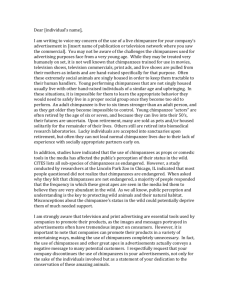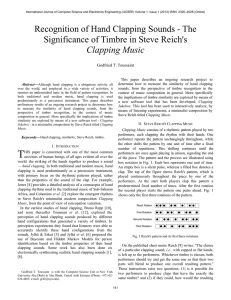Brain imaging procedure details and additional analyses & figures
advertisement
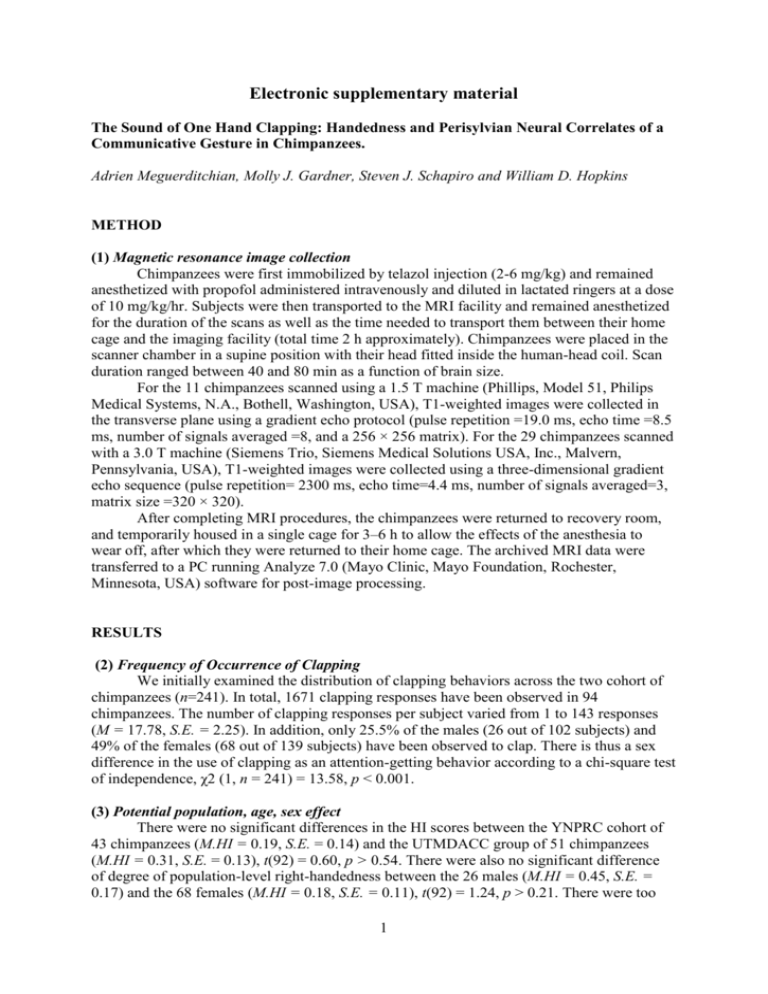
Electronic supplementary material The Sound of One Hand Clapping: Handedness and Perisylvian Neural Correlates of a Communicative Gesture in Chimpanzees. Adrien Meguerditchian, Molly J. Gardner, Steven J. Schapiro and William D. Hopkins METHOD (1) Magnetic resonance image collection Chimpanzees were first immobilized by telazol injection (2-6 mg/kg) and remained anesthetized with propofol administered intravenously and diluted in lactated ringers at a dose of 10 mg/kg/hr. Subjects were then transported to the MRI facility and remained anesthetized for the duration of the scans as well as the time needed to transport them between their home cage and the imaging facility (total time 2 h approximately). Chimpanzees were placed in the scanner chamber in a supine position with their head fitted inside the human-head coil. Scan duration ranged between 40 and 80 min as a function of brain size. For the 11 chimpanzees scanned using a 1.5 T machine (Phillips, Model 51, Philips Medical Systems, N.A., Bothell, Washington, USA), T1-weighted images were collected in the transverse plane using a gradient echo protocol (pulse repetition =19.0 ms, echo time =8.5 ms, number of signals averaged =8, and a 256 × 256 matrix). For the 29 chimpanzees scanned with a 3.0 T machine (Siemens Trio, Siemens Medical Solutions USA, Inc., Malvern, Pennsylvania, USA), T1-weighted images were collected using a three-dimensional gradient echo sequence (pulse repetition= 2300 ms, echo time=4.4 ms, number of signals averaged=3, matrix size =320 × 320). After completing MRI procedures, the chimpanzees were returned to recovery room, and temporarily housed in a single cage for 3–6 h to allow the effects of the anesthesia to wear off, after which they were returned to their home cage. The archived MRI data were transferred to a PC running Analyze 7.0 (Mayo Clinic, Mayo Foundation, Rochester, Minnesota, USA) software for post-image processing. RESULTS (2) Frequency of Occurrence of Clapping We initially examined the distribution of clapping behaviors across the two cohort of chimpanzees (n=241). In total, 1671 clapping responses have been observed in 94 chimpanzees. The number of clapping responses per subject varied from 1 to 143 responses (M = 17.78, S.E. = 2.25). In addition, only 25.5% of the males (26 out of 102 subjects) and 49% of the females (68 out of 139 subjects) have been observed to clap. There is thus a sex difference in the use of clapping as an attention-getting behavior according to a chi-square test of independence, χ2 (1, n = 241) = 13.58, p < 0.001. (3) Potential population, age, sex effect There were no significant differences in the HI scores between the YNPRC cohort of 43 chimpanzees (M.HI = 0.19, S.E. = 0.14) and the UTMDACC group of 51 chimpanzees (M.HI = 0.31, S.E. = 0.13), t(92) = 0.60, p > 0.54. There were also no significant difference of degree of population-level right-handedness between the 26 males (M.HI = 0.45, S.E. = 0.17) and the 68 females (M.HI = 0.18, S.E. = 0.11), t(92) = 1.24, p > 0.21. There were too 1 few young subjects (n=8) for evaluating the difference of population-level handedness with the 85 adult individuals. (4) Consistency of hand preferences across time. In addition, hand preference data for 22 subjects were recorded 3 years after the initial observations by a second observer that was blind to the first set of data. Test-retest correlation between the HI scores for these 22 subjects showed a significant positive correlation, r(22) = 0.93, p < 0.0001. Only 5 subjects showed variation of their HI between the two sessions. While these individuals belonged to the 13 subjects of the whole sample that performed nonexclusive hand use in the first session, these 5 subjects had exclusive hand preference in the second session. Moreover, the mean ABS-HI that reflects the strength of handedness at a population-level approached the maximum (= 1) on the overall sample of 94 subjects: Mean = 0.92, S.E. = 0.02. These findings confirm that clapping elicits robust and nearly exclusive hand preference. (5) Potential effect of the number of responses on hand preference As the number of responses per subject varied from 1 to 141 for clapping in our sample of subjects, we evaluated the potential variations of the patterns of results according to the number of responses per subject. For this purpose, we created a funnel plot in which the number of responses was plotted against the individual percentage of right-hand use. As can be seen in the figure, when the number of responses per subject increased, the number of ambiguously handed individuals (that could be seen in the center of the funnel between the lines drawn by black lozenges and the white triangles) decreased whereas the number of individual that had exclusive hand preference for the right or the left hand did not vary. Thus, these analyses indicate that our hand preference classification data were not biased due to differences in the number of responses among subjects. Figure 1. Funnel plot of the individual percentages of right hand plotted against the number of observations in hand use for clapping. The grey circles are the percentage of right-hand use for each subject based on the number of individual observations of hand use for clapping (i.e., Nb of Responses). For each subject and its corresponding number of responses, there is a black lozenge and a white triangle that represent the theoretical critical percentages of right-hand use in which zscore values (+1.96 and -1.96 respectively) are at p < 0.05. Then, grey circles that lie above the black lozenges' line (z = 2 +1.96) represent subjects with significant right-hand preferences (p < 0.05). Grey circles that lie below the white triangles' line (z = -1.96) represent subjects with significant left-hand preferences (p < 0.05). Grey circles that lie between the two lines represent those individuals who fail to show a significant hand preference. Grey circles that lie at the extreme top or bottom lines of the graph (0 or 100%) represent subjects with exclusive hand preferences. DISCUSSION (6) Comparison of hand preference between different manual behaviors in chimpanzees Figure 2. Comparison of the degrees of population-level handedness (M.HI) between clapping and other manual tasks reported in a previous studies (see [59] for full description of these behaviors) such as non communicative actions (selfdirected nose-wipe which consisted of self-touching the nose; bimanual coordinated tube task which consisted of holding a PVC tube with one hand and remove the food inside the tube with the finger of the other hand) and communicative gestures (food beg which consisted of extending the finger through the mesh of the cage for begging for out-of-reach food from a human ; species-specific gestures which consisted of manual signals used in intra-specific communication such as threat, extending arm, hand slap). M.HI scores ± S.E. The error bar represents the standard error (S.E.) around the mean of HI scores (M.HI). Asterisks indicate that the M.HI score differed significantly from zero. *p < 0.05. The sign of the M.HI values indicates the direction of the group-level handedness (positive: group-level right-handedness, negative: group-level lefthandedness). REFERENCE 59 Meguerditchian, A., Vauclair, J., & Hopkins, W. D. 2010 Captive chimpanzees use their right hand to communicate with each other: Implications for the origin of the cerebral substrate for language. Cortex 46, 40-48. (doi: 10.1016/j.cortex.2009.02.013) 3



